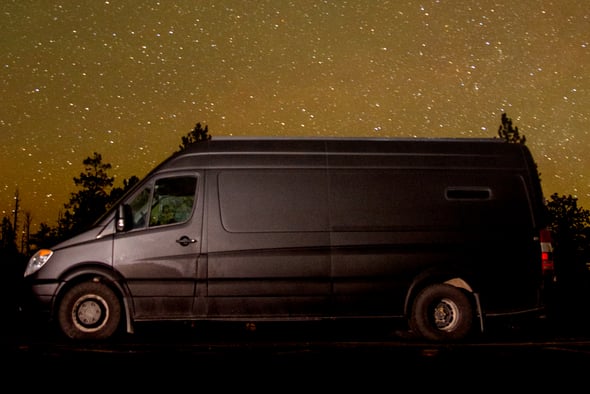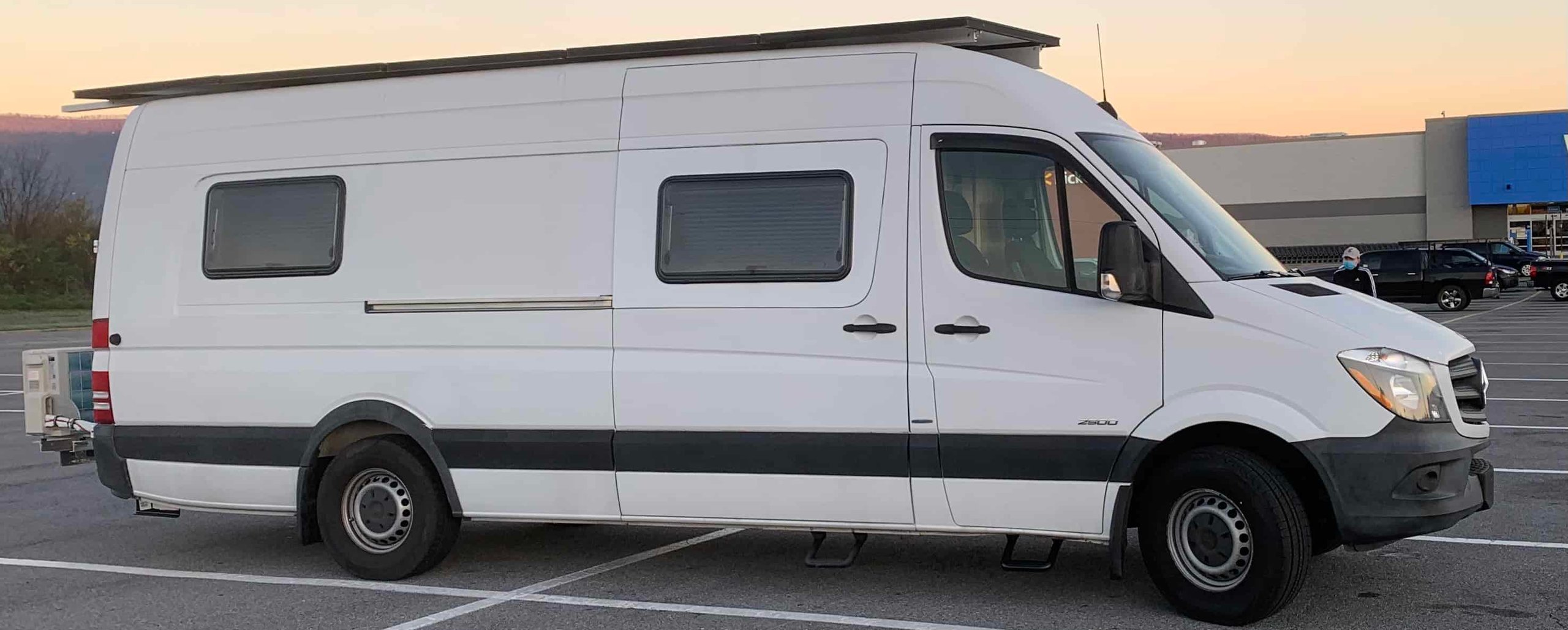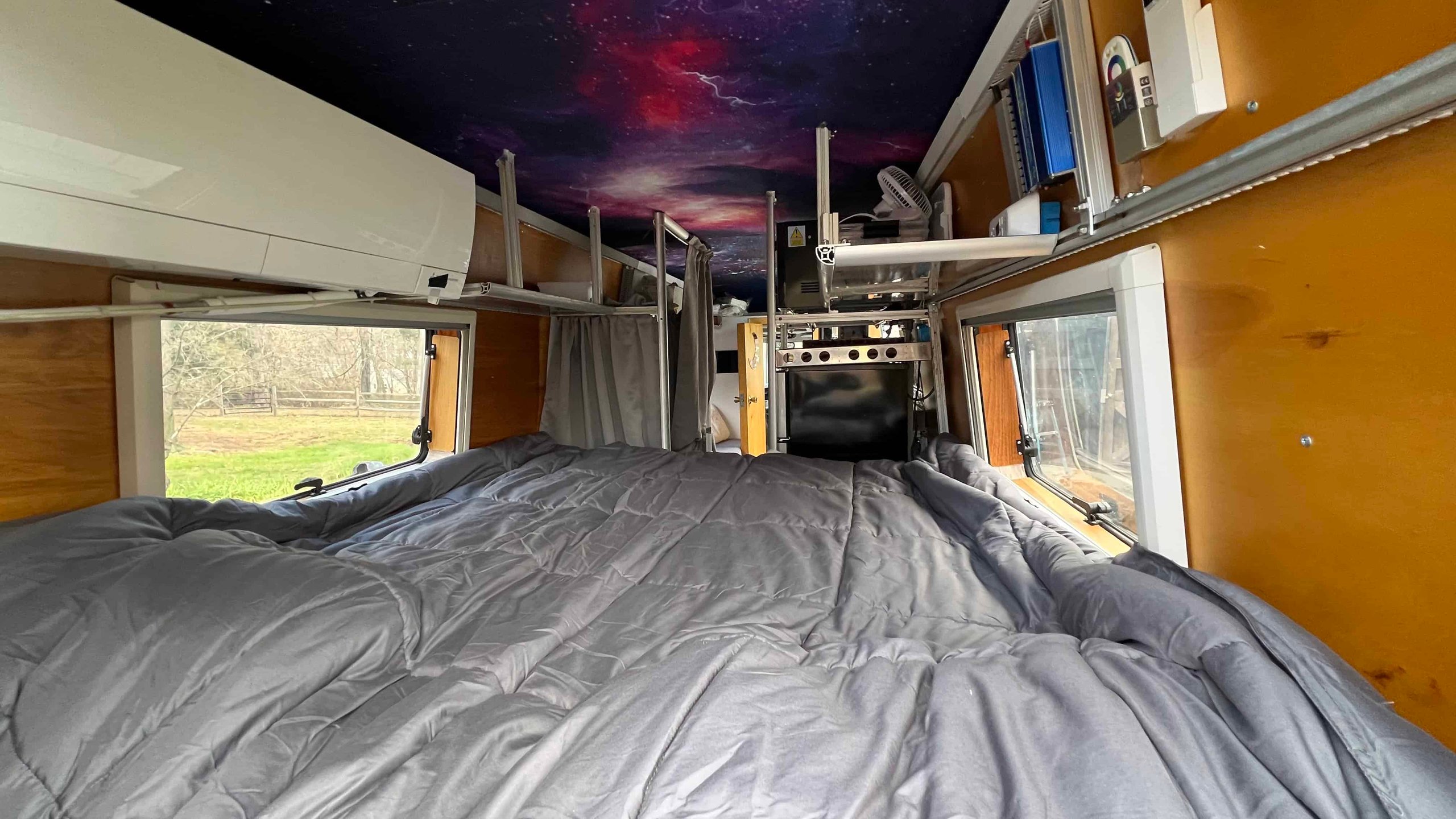My wife is making me do this: Reason for selling, I started building my electric Xenos airplane and she says I can’t keep both. This four season off-grid semi-stealth van was built by me in 2021. I am an electrical engineer, a jack of all trades, and an aircraft builder… but especially skilled at high-power, high-voltage systems. During the COVID lockdown, I took the time to re-imagine what a camper van could be by adapting Elon Musk’s design philosophy:
1. Making the requirements less dumb. (No pitifully small fans or loud, inefficient AC compressors on the roof. No holes in roof or side to prevent water intrusion, open architecture. Eliminated heavy cabinets. Lightweight ceiling, side, and front bulkhead.)
2. Delete the part or process. (One faucet. No sink. No gray water plumbing. No propane. No shower. No need for winterization.)
3. Simplify and optimise the design. (Only one water pipe needed. One tank for black and gray water. Streamline exterior.)
I also incorporated knowledge gained from over 200 youtube videos and websites: an insulated living space, powerful electrical, HVAC and water systems that maximize off-grid ability, with all the conveniences as shown below. A Winnebago engineer said it is at least five years more advanced than anything on the market in terms of:
LIVING SPACE
True Four-season capability. Fully foam insulated.
Mitsubishi heat pump heats down to -13F. Cools well in summer. It’s Q U I E T
Dual pane acrylic glass windows are 10x more efficient than single-pane glass
Stealth camping: No big holes on side of van. Looks like a solar / HVAC service van.
Open architecture: Easily make changes to this camper for both electrical and mechanical systems. All wires are
Propane-free: no smelly gas. Residential fridge, microwave-convection oven and induction cooktops
Water-reuse: Sink is a small tub. Reuse water for flushing toilet.
Toilet is vitreous china…best quality. The toilet space is small and it has curtains, in accordance with the “open-architecture”. The curtains only provide visual privacy.
Ubiquitous: Bed can be split to carry 4ftx8ft sheets of lumber or large items if you have a run to the hardware store
BIG basement for e-bikes or other toys
Baking: Convection oven does cookies and other tasty camping treats
Fresh air systems: BIG fan Vent system has 5x more flow. Windows have “crack mode” that lets in fresh air but resists water intrusion.
Aluminum used in the van is reclaimed, including the floor, bed couch and 80/20 aluminum internal structure.
LED strip lighting with four remote controls. Try different colors or party mode.
Couch can seat up to four people. It can sleep up to two thin adults (We’ve done it) or two kids. The foam cushions are designed to insert and make more sleeping room. The couch has a slide-out aluminum panel to extend the sleeping space.
VAN SYSTEMS
Passed Pennsylvania inspection in November, 2023
Engine runs well. No warning lights. Uses no oil. DEF Upgrade done by Mercedes dealer.
AC blows cold.
Up to 25MPG due to good aerodynamics: smooth roof
Although the interior of this van does not need winterization if you keep the heat pump on. There are four items to consider: The water tank, toilet and Tesla battery are inside the heated space. However, the waste water tank is unheated and needs about 10% pink RV fluid during winter to prevent freezing. I decided to do this because it does not require power to keep the waste tank from freezing. The Tesla battery will not charge at or near freezing temperatures, but it will provide power well below freezing. I usually have two 250 watt parabolic heaters on a thermostat, which keeps the interior around 40F while the van is in storage.
Lift kit installed to raise rear end.
Four seat belts are installed behind the couch.
TO BE DONE
Cosmetic improvements: Putting white or wood contact paper on interior side panels. Re-install original plastic trim.
Cover over some insulation.
POWER SYSTEMS
New owner should be versed in windows PC operation and have the ability to judge power requirements. For example, if running from an RV 50 amp outlet, the charger needs to be set for 30 amps. If you are charging from a household 120VAC outlet, set the BMS for 10 amps. This only takes a few minutes, once familiar with the App. The photo shows an App called Orion BMS, which controls charging and discharging the battery.
A large breaker box has breakers, fuses, relays, switches and two automatic transfer switches to control shore power, battery and solar power.
There are two 8KW pure sine wave inverters; one for 120 VAC and one for 220VAC.
There is an industrial strength 6.6KW charger that is controlled by the Orion BMS system.
BIG battery: 92 VDC Tesla Model 3 lithium battery, 20KWH
BIG solar: 1800 Watts on top of van. Sunpower panels. Can generate up to 80% more power.
Instant hot water (six seconds) from 3KW electric faucet, using the 220VAC 8KW inverter
Quick charging: 50 Amp, 50ft RV cord reel or J1772 EV charging
This van is being sold as-where-is with no guarantees or warranty. A user manual will be provided, complete with a schematic diagram of all power systems, including solar power. It will include instructions on how to set up charging and manage the battery.




















